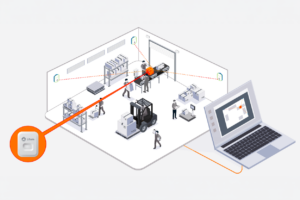What is Indoor Asset Tracking?
Indoor Asset Tracking involves monitoring and locating assets within indoor environments, such as warehouses, factories, or other enclosed facilities. This offers real-time data on the location, movement, and condition of assets, which could be anything from inventory and machinery to staff.
Why is Indoor Asset Tracking Important?
Indoor asset tracking is a vital component in enhancing operational efficiency, reducing costs, and maximizing asset utilization. Real-time visibility of asset locations can streamline workflows, mitigate losses or theft, improve inventory management, and uplift overall productivity.
How Does Indoor Asset Tracking Work?
Indoor asset tracking hinges on Real-time Location Systems (RTLS) to determine the location of assets in real time. While technologies like radio frequency identification (RFID), Bluetooth Low Energy (BLE), Ultra-Wideband (UWB), and Wi-Fi are frequently utilized, the choice can influence accuracy, range, and system costs. These systems usually comprise tags for assets, environment-placed anchors or receivers, a network for data communication, and software to process and display this data.
Components of Indoor Asset Tracking Systems
Understanding the key components of indoor asset tracking systems can provide a deeper insight into functionality. These key components include:
Tags and Transponders
Affixed to assets for identification, these devices might be passive RFID tags (which are powered by the reader’s signal), active RFID tags, BLE beacons, or UWB tags (both of which have their power source). They send signals processed by anchors or receivers.
Anchors and Receivers
These stationary units collect signals from tags, deducing asset positions based on signal strength or time-of-flight. Strategic deployment is essential for optimal system accuracy.
Network Infrastructure
The network infrastructure is the backbone of the indoor asset tracking system. It facilitates communication between tags, anchors or receivers, and the central software platform. This infrastructure often includes wired or wireless connections, such as Ethernet, Wi-Fi, or cellular networks, to transmit data between the system components.
Software and Analytics
The software and analytics component processes the collected data, visualizes asset locations, and provides insights to end-users. This part of the system often includes a central management system or dashboard that allows users to track assets, set up geofences, generate reports, and integrate with other enterprise systems.
Benefits of Indoor Asset Tracking
While benefits can hinge on the system type, its quality, and how well it’s integrated, indoor asset tracking typically offers:
Increased Visibility and Control
Indoor asset tracking enhances real-time visibility into the location and movement of assets, granting businesses a comprehensive overview of their inventory. This improved visibility assists in optimizing workflows, reducing search time, preventing loss or theft, and augmenting asset utilization.
Enhanced Efficiency and Productivity
Through precise tracking of assets, businesses can streamline operations, automate manual processes, and diminish human errors. Asset tracking systems deliver insights into asset utilization patterns, enabling businesses to identify bottlenecks, enhance workflows, and distribute resources effectively, leading to increased efficiency and productivity.
Cost Reduction and Asset Optimization
Indoor asset tracking aids in preventing asset loss or misplacement, thus reducing the frequency of replacements or additional purchases. By optimizing asset utilization and minimizing idle time, businesses can circumvent unnecessary expenses, make informed procurement decisions, and allocate resources more effectively.
Choosing the Right Indoor Asset Tracking System
The selection of the most suitable indoor asset tracking system for your business demands careful consideration of several factors. The optimal system demands scrutiny of:
- Accuracy Requirements: Determine the level of accuracy needed for your specific use case. Some applications, such as high-value asset tracking, may necessitate higher precision than others.
- Technology Compatibility: Take into account how the asset tracking system will meld with your enterprise systems and existing infrastructure, including Wi-Fi networks, RFID systems, or other technologies already deployed. Seamless integration with other systems, such as inventory management or enterprise resource planning (ERP) software, can streamline workflows and enhance data accuracy.
- Scalability: Reflect on the system’s scalability to accommodate future growth or changes in your asset tracking needs. Opt for an asset tracking system that can scale with your business requirements. Verify that the system supports an adequate number of assets, provides expansion options, and can adapt to changes in your environment or operations.
- Total Cost of Ownership: Calculate the total cost of ownership, encompassing upfront costs, maintenance, and potential integration expenses, to ensure the solution is financially viable.
- Environmental Factors: Some environments might interfere with signals, affecting accuracy.
- Battery Longevity: If tags are battery-operated, consider the frequency of replacement or recharge.
Implementing an Indoor Asset Tracking System
Implementing an indoor asset tracking system involves several crucial steps:
Planning and Preparation
- Define tracking objectives.
- Pinpoint assets to track and select suitable tags.
- Conduct a site analysis to determine the best receiver placements.
- Draft a timeline, budget, and resource plan.
Installation
- Base anchor placements on site survey insights.
- Attach tags as per guidelines.
- Configure the network for seamless data relay.
- Integrate the tracking system with existing software.
Testing and Calibration
- Thoroughly test for functionality.
- Calibrate for desired accuracy.
- Cross-check real-time tracking results against actual data.
Training and Adoption
- Train all relevant staff comprehensively.
- Highlight system advantages to employees.
- Promote adoption by sharing success narratives and addressing issues.
Post-Implementation Evaluation
- Periodically assess the system’s efficacy.
- Make necessary adjustments to ensure optimal performance.
Applications of Indoor Asset Tracking
Indoor location technologies find a variety of applications across different industries, including:
Manufacturing and Warehousing
Manufacturers and warehouse operators use asset tracking systems to keep tabs on inventory, tools, and equipment, optimizing supply chain management, reducing stockouts, preventing equipment loss, and improving operational efficiency.
Healthcare
In healthcare settings, indoor asset tracking is essential for locating medical equipment, tracking patient flow, and monitoring the status of critical assets. Healthcare RTLS can enhance patient care, reduce equipment search time, and ensure regulatory compliance.
Retail
Retailers can leverage indoor asset tracking to monitor inventory levels, track high-value items, prevent theft, and optimize stock replenishment. Real-time visibility into stock availability can improve customer service and minimize stockouts.
Hospitality
Hotels and facilities management companies can benefit from asset tracking systems to monitor the location and condition of assets such as furniture, equipment, or maintenance tools. This simplifies asset management, reduces loss, and enhances maintenance processes.
Overcoming Challenges in Indoor Asset Tracking
While indoor positioning systems offer significant benefits, there are challenges that need to be addressed:
Interference and Signal Strength
Indoor environments may introduce signal interference due to obstacles, walls, or electromagnetic interference from other devices. These challenges can be mitigated through careful planning, strategic placement of anchors, and appropriate technology selection.
Accuracy and Precision
Achieving high levels of accuracy and precision can be challenging in complex indoor environments due to factors such as multipath signals, signal attenuation, and environmental changes. Regular calibration and optimization can help manage these issues.
Privacy and Data Security
Asset tracking systems collect and process sensitive data, such as asset locations and movement patterns. It is crucial to have proper security measures in place to protect this data from unauthorized access or misuse. Compliance with relevant data protection regulations and the establishment of data governance policies is vital.
Best Practices for Indoor Asset Tracking
For a successful implementation and sustained benefits from your indoor asset tracking system, embrace these best practices:
Regular Maintenance and Upgrades
It is crucial to conduct consistent maintenance checks and apply firmware updates to ensure optimal system operation. Make sure to address malfunctioning components without delay. You should also periodically assess the system’s performance and contemplate updates to harness new technologies or features.
Data Analytics and Visualization
Make the most of the data accumulated by your asset tracking system. Utilize analytics tools to discern patterns, refine workflows, and support data-driven decisions. Present asset locations and movement data on user-friendly dashboards for straightforward comprehension for users.
Continuous Process Improvement
It is essential to regularly review and evaluate the effectiveness of your asset tracking system. By actively seeking feedback from end-users and stakeholders, areas for improvement can be identified. In response to this feedback and changing business needs, processes should be refined, workflows updated, and the system adapted accordingly.
Future Trends and Innovations in Indoor Asset Tracking
As technology continues to advance, the future of indoor asset tracking is set to be defined by greater precision, automation, and integration with other smart systems. Innovations such as ultra-wideband (UWB) technology, artificial intelligence, and the Internet of Things (IoT) are driving the development of more accurate and efficient tracking solutions. These technologies enable real-time visibility and analytics, helping businesses optimize asset utilization, reduce losses, and enhance operational efficiency.
The indoor asset tracking realm is on an upward trajectory. Here are some emergent trends and innovations to keep an eye on:
IoT Integration and Sensor Fusion
Merging asset tracking systems with the Internet of Things (IoT) paves the way for capturing richer contextual data. Integrating location data with other sensor data with metrics like temperature, humidity, or vibration provides businesses a more holistic understanding of asset states and efficiency.
Artificial Intelligence and Machine Learning
The rise of artificial intelligence (AI) and machine learning (ML) is enhancing data scrutiny and predictive prowess. AI-driven asset tracking systems can spot inconsistencies, determine patterns, and optimize asset utilization based on historical and real-time data.
5G and Edge Computing
The roll-out of 5G and the potential of edge computing assure swifter data transfer, diminished latency, and heightened system reactivity. These breakthroughs bolster real-time asset tracking and empower the launch of more sophisticated applications.
Get Indoor Asset Tracking Solution by Litum
Indoor location tracking via RTLS provides precise and efficient means for businesses to improve visibility control, and efficiency. Its precision surpassed that of outdoor asset tracking systems. Accurate tracking of assets in indoor settings allows businesses to enhance operations, minimize costs, and bolster productivity. It is imperative to select an appropriate system, strategize its implementation, and address potential challenges to achieve successful asset tracking.
To navigate the complexities of indoor asset tracking, having a trusted partner like Litum can make a major difference. Consider consulting with us for expert guidance on integrating indoor asset tracking within your organization.



